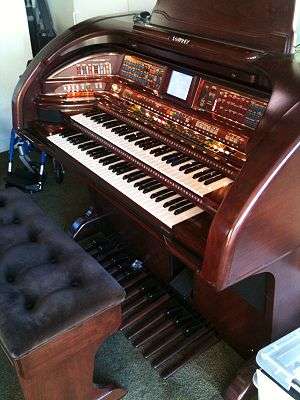Vox Jaguar
The Vox Jaguar is a combo organ that was built in the 1960s, one of many models of popular portable transistor organs of its time. Built in Italy by GEM (Galanti Electro Musical) under license by Jennings Musical Instruments from 1966 to 1967, and then by EME until 1971, it was a budget model visually based on the very popular Vox Continental. It had a single manual of four octaves (49 keys) and was built into the Continental's cabinet.
Its technology was far less intricate, but the Jaguar still managed to produce a decent combo organ sound. It featured rocker switch tabs in place of the Continental's drawbars, and the first 12 notes were a "reversible" bass octave ("Walk" Bass/"Chord" Bass) with typical black-on-white keys. The main keyboard, like the Continental's, was white-on-black. It also featured a separate output for the bass notes, allowing a separate connection into a bass amplifier for "stereo" playing. At introduction, while the Jaguar featured only an "Off/On/Bass Volume" knob in addition to the tabs, its sibling model the "Corinthian" additionally featured a "Contour" (tone) knob. In 1968, the "Corinthian" name was dropped, and the latter instrument became the Jaguar (the original Jaguar being dropped from production).
Some enthusiasts and players appear to be less impressed with the Jaguar's general quality in comparison to that of the Continental, though many agree that, for the money, it was a reasonably cost-effective substitute, and is still one of the better known vintage combo organ models. The Jaguar was not a particularly sturdy instrument, and its best recommended usage was for garage-bands, playing in small clubs, private parties, or the home studio. It was not considered suitable for heavy professional gigging. Heathkit offered a version of the Vox Jaguar for assembly by the purchaser in 1968.
